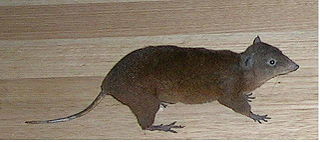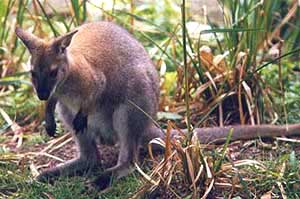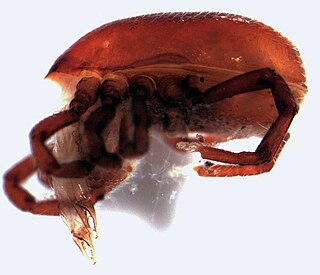
Trombicula, known as chiggers, red bugs, scrub-itch mites, or berry bugs, are small arachnids in the Trombiculidae family. In their larval stage, they attach to various animals, including humans, and feed on skin, often causing itching. These relatives of ticks are nearly microscopic, measuring 0.4 mm (0.01 in) and have a chrome-orange hue. A common species of harvest mite in North America is Trombicula alfreddugesi; in the UK, the most prevalent harvest mite is Trombicula autumnalis.

The musky rat-kangaroo is a small marsupial found only in the rainforests of northeastern Australia. First described in the later 19th century, the only other species are known from fossil specimens. They are similar in appearance to potoroos and bettongs, but are not as closely related. Their omnivorous diet is known to include materials such as fruit and fungi, as well as small animals such as insects and other invertebrates. The local Aboriginal name for the species is durrgim yuri.

The Hypsiprymnodontidae are a family of macropods, one of two families containing animals commonly referred to as rat-kangaroos. The single known extant genus and species in this family, the musky rat-kangaroo, Hypsiprymnodon moschatus, occurs in northern Australia. During the Pleistocene, this family included the megafauna genus Propleopus.

Hypsiprymnodon is a genus of macropods. The sole extant species is Hypsiprymnodon moschatus, the musky rat-kangaroo. The genus includes four known fossil species.

Ekaltadeta is an extinct genus of marsupials related to the modern musky rat-kangaroos. Ekaltadelta was present in what is today the Riversleigh formations in Northern Queensland from the Late Oligocene to the Miocene.

The Macropodiformes, also known as macropods, are one of the three suborders of the large marsupial order Diprotodontia. Kangaroos, wallabies and allies, bettongs, potoroos and rat kangaroos are all members of this suborder.

The Holothyrida are a small order of mites in the superorder Parasitiformes. No fossils are known. With body lengths of more than 2 mm they are relatively large mites, with a heavily sclerotized body. They mainly feed on the body fluids of dead arthropods. This was possibly the common way of feeding for ticks before they adapted for feeding on the blood of live animals.

Ornithonyssus is a mite genus of the family Macronyssidae.

Androlaelaps is a genus of mites in the family Laelapidae.
The Macronyssidae are a family of parasitic mites in the order Mesostigmata.

The Laelapidae are a family of mites in the order Mesostigmata. The family is also referred to in the literature as Laelaptidae, which may be the correct spelling.
Ologamasidae is a family of mites in the order Mesostigmata.
Ameroseiidae is a family of mites in the order Mesostigmata.

Proctolaelaps is a genus of mites in the family Ascidae.
Ljunghia is a genus of mites in the family Laelapidae.
Mesolaelaps is a genus of mites in the family Laelapidae. The small macropod species Hypsiprymnodon moschatus, the musky rat kangaroo, is recorded as a to host species of this mite.
Pseudoparasitus is a genus of mites in the family Laelapidae.
Hirstionyssidae is a family of mites in the order Mesostigmata.

Rhinonyssidae is a family of mites in the order Mesostigmata.
Paramegistidae is a family of mites in the order Mesostigmata.










